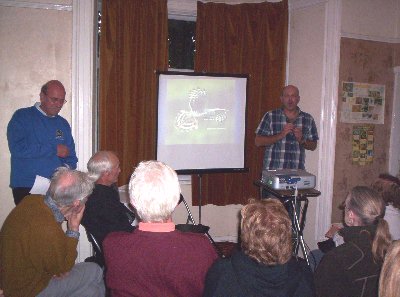RSPB 'Birds of Prey' 14/6/10 |
|||||||||||||
| The room was filled to capacity with 33 people attending tonight's
event, which I think it is safe to say, was a success. Roy Taylor of the
RSPB came along to speak to us on the subject of "Birds of Prey". An excellent
speaker who was able to recount many experiences he had had not only sighting
these birds but taking part in projects to re-introduce them and set up areas
of protection for them.
The birds which were given a particular mention included the Kestrel, Osprey,Peregrine Falcon, Hobby, White Tailed Eagle,Golden Eagle, Red Kite, Buzzard, Merlin, Harrier and Marsh Harrier, Long eared and Short eared Owls and Barn Owl with superb slides to accompany his commentary. It was very encouraging to know that at no other time have birds of prey been doing so well and prospering throughout the UK. Many birds which have been depleted to as little as 2-3 pairs, through the conservation efforts of RSPB and many volunteers setting up protective areas and challenging legislation, have now increased their numbers and are adapting well to the change in their new environments. An interesting insight into relationships between populations is that the Great Tit population in one of RSPB surveys was unaffected by the Sparrowhawks and this was shown because the numbers of Great tits remained steady even though the Sparrowhawks had been present and then absent. Roy also showed how some birds of prey can kill foxe - another apex predator. The Peregrine has taken to city dwelling - and will take pigeons as food - which are often seen as 'pests',and so it is an antidote to poisoning birds which is environmentally unfriendly to both birds and humans. Roy stated that the birds that he had mentioned would not decimate the squirrel population but in principle,any rodent increasing in numbers is a target for such birds. It is therefore unnecessary for humans to mess with the population dynamic unless populations are on the verge of extinction.
Non-lethal methods of control can be introduced - in
the case of the buzzard
which has seen a comeback. Large rings can be painted onto prey to stop the
buzzard from attacking it. A short question and answer session followed the main talk and then we had refreshments while we had a slide show of all the MTVCA's events this year.
RSPB Campaign |
RSPB - Planting for Garden
Birds
|
|||||||||||||
